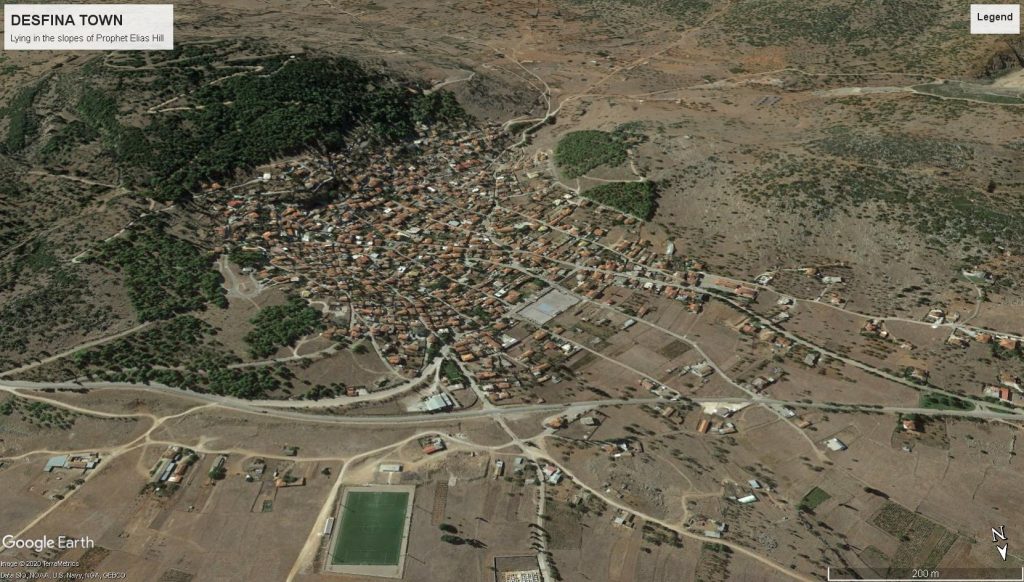The town of Desfina
Video inteview with local sheperds.
Desfina
(Greek: Δεσφίνα) is a lovely town and a former municipality in the southern part of Phocis, Greece. Despite its small population it occupies the larger registry area in land amongst other Greek towns extending from the Corinthian Gulf to the plateau facing Delphi.
Since the 2011 local government reform it is part of the municipality of Delphi, of which it is a municipal unit.
Ruins near Desfina have been identified or are under documentation; for example the ancient town of Echedameia which was destroyed by King Philip II of Macedon around 355-346 BC during the Third Sacred War and was never rebuilt.
However around 4km to the east, a recent discovery of a significant settlement dated at least from Late Mycenaean or Late Helladic IIIB-C times that of Kastrouli have been equated with Homeric Anemoreia.
During the Hellenic Revolution against Ottoman-Turkish occupants for independence one of the most important rebels was Bishop Isaias of Salona/Amfissa, fought for the liberation of Desfina until his execution by the Turks on 22 April 1821 and encouraged Athanasios Diakos for the battle of Alamana. Also, Isaias gave the signal for the beginning of revolution of Central Greece at the region of Prophet Daniel. His residence is found in Desfina and has been converted to a museum.
In Desfina there are significant and worth seeing places: the Monastery of John the Forerunner of 17th c, the important Byzantine little Chapel of Saint Brigadiers 14 c. AD, near to the church of Saint Haralampos dated by inscription.
Also, valuable wall paintings (hagiography) in Aghios Demetrios, Prophet Elias and on Sanctum doors in Church, crosses etc, are worth seen as were made by local artist Spyros Papaloukas. (1892-1957).
S.Papaloukas in Paris, where he stayed for four years (1917-1921), he painted non-stop and visited museums and galleries. He sees the revolution that has taken place in art, he tries to understand it, but he rejects any idea of imitation. It is the time when all the great upheavals of modern art have already taken place: fobism, Impressionism, Cubism, Expressionism, Subtraction, and Surrealism is emerging. After all, Papaloukas belongs to the same generation as the surrealist painters. But none of these currents directly affects him. His “obsession with the object” will bring him closer to the post-impressionist movements, from which all modern Greek modernists draw lessons.
The influence of Papaloukas on his contemporaries and later Greek painters was catalytic, since with his work he showed that modern art and Greekness are not incompatible concepts. He followed his own path, thus conquering a peculiar personal way of expression, reconciled with the tradition that he faithfully followed, through a modern visual look.
Other worth visiting places include the water spring in the slopes of Prophet Elias in the norther part of the town forming a cave shelter (tyrias), where shepherds kept their cheese due to low temperature that prevails, and major source of water.
The prophet Elias hill with the picturesque little chapel and fantastic view of the plain, was a prehistoric site judging from the abundance of obsidian tools found scattered in the top surface of this hill. During the winter two depressions outside the town -at eastern Limnos and western Meteles- gather water for 1-3 months and turn to a seasonal lakes. Of particular attention is the observation of two sinkholes at Meteles constructed on purpose to dry the land from ancient people.
A large employer in the area of Desfina is Aluminium of Greece, which has a production facility at nearby Aspra Spitia-Antikyra. In the past, the locals were mainly sustained by animal breeding and husbandry. The most important traditional products in the region are bakery products, olives and oil, grapes and wine, meat, cheese products and honey, and the Desfina plateau grow several herbs for botanological purposes.
The Christmas and the Easter are celebrated with particular way mainly in villages and small town. Desfina is a town where the customs, the traditions and the feasts are still kept to a large extent. The most important festivities take place in August. The most important event is the feast of the Dormition of the Virgin Mary, which is celebrated on 15 August. Dancing, signing, races for all ages are but a few activities taken place for 2 weeks. The Chorus and dancing groups are famous and travelled by invitation to other cultural events in Greece and abroad.
There are several historical monuments and temples in Desfina as well as the central square which dates back to the 19th century. The square of Desfina is encircled by traditional cafes and taverns, while the smooth hills and plains offer a view of Mount Parnassos.
The Cultural Association of Desfina I Proodos (“The Progress”) was founded on 6 July 1979 and today numbers 200 members. The aim of the cultural association is the intellectual growth and moral culture, the promotion of spirit of culture and humanitarian bond between the members as well as contribution in the configuration of environment. The choir of Desfina, founded in 1999, consists of an adult’s and a children’s section.
There are two football clubs in Desfina: Isaias Desfina, founded in 1973, and Doxa Desfina, founded in 1986.
Desfina has all basic environmental and cultural elements to develop a sustainable town.
Overall, the cultural activities at the Desfina town and the Kastrouli Project are attractions which are worth visiting and from this site NEWS concerning such events and new finds shall be announced and updated.


